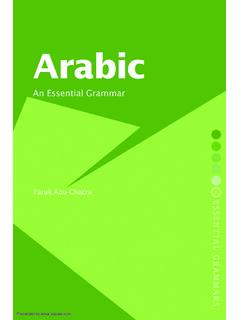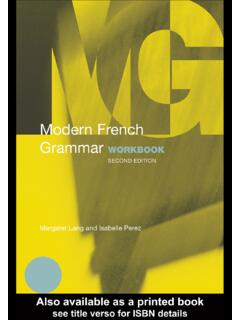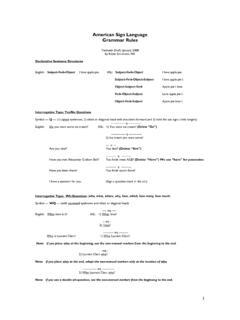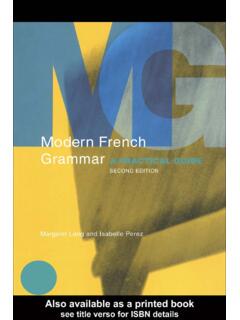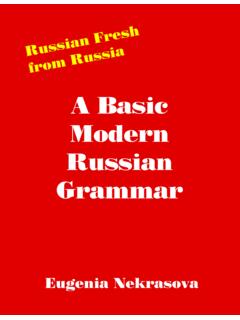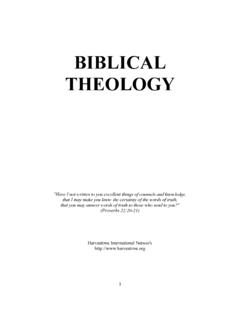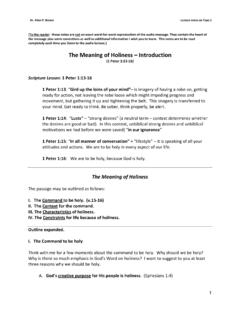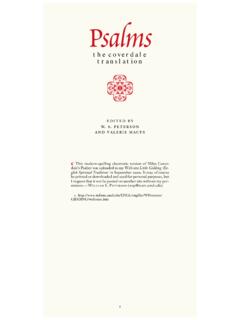Transcription of Hebrew Biblical Hebrew - Live, 1-to-1
1 learn to read Biblical Hebrew learn to read Biblical Hebrew 2 learn to read Biblical Hebrew 3 learn to read Biblical Hebrew A guide to learning the Hebrew alphabet, vocabulary and sentence structure of the Hebrew Bible ~~~~~~~~~~~~~~~~~~~~~~~~~~~~~ By Jeff A. Benner learn to read Biblical Hebrew 4 Cover design by Jeff A. Benner. learn to read Biblical Hebrew , by Jeff A. Benner. Published 2007 by Publishing Inc., Box 9949, College Station, TX 77845, US. 2003, Jeff A. Benner. All rights reserved. Any part of this book may be copied for educational purposes only, without prior permission. Manufactured in the United States of America. learn to read Biblical Hebrew 5 Table of Contents INTRODUCTION .. 7 PART 1 THE ALEPHBET .. 11 LESSON 1 ALEPH, BEYT.
2 15 LESSON 2 MEM, YUD .. 17 LESSON 3 NUN, HEY .. 19 LESSON 4 LAMED, VAV .. 21 LESSON 5 RESH, SHIN .. 23 LESSON 6 AYIN, TET .. 25 LESSON 7 TAV, DALET .. 27 LESSON 8 TSADE, QUPH .. 31 LESSON 9 CHET, KAPH .. 33 LESSON 10 ZAYIN, PEY .. 35 LESSON 11 GIMEL, SAMECH .. 37 LESSON TRANSLITERATIONS .. 39 PART 2 READING PRACTICE .. 45 THE Hebrew .. 46 TRANSLITERATION .. 49 PART 3 REFERENCE GUIDE .. 53 PART 4 TRANSLATING LESSONS .. 59 LESSON 1 GENESIS 1 61 LESSON 2 GENESIS 1 66 LESSON 3 GENESIS 1 72 LESSON 4 GENESIS 1:4 & 5 .. 76 PART 5 Hebrew /ENGLISH DICTIONARY .. 78 PART 6 PARENT / CHILD ROOTS .. 98 PART 7 ADOPTED ROOTS .. 124 learn to read Biblical Hebrew 6 To my Father who set me on the path of Biblical studies learn to read Biblical Hebrew 7 IInnttrroodduuccttiioonn _____ Why learn Hebrew ?
3 A translation of the Biblical text is a translator's "interpretation" of the text. The translator's beliefs will often influence how the text will be translated and anyone using his translation is seeing it through his eyes rather than the original authors. Only by studying the original language of the Bible can one see the text in its original state. Learning the Hebrew language can be both fun and exciting. By simply studying the pages that follow, for just a few minutes a day, you will soon be reading Hebrew , build a Hebrew vocabulary and even begin translating Biblical passages for your self. About Hebrew The English word "alphabet" is derived from the first two letters of the Greek Alphabet--Alpha and Beta.
4 Hebrew on the other hand, uses the word "alephbet," the first two letters of the Hebrew alephbet--aleph and bet. The Hebrew learn to read Biblical Hebrew 8 alephbet consists of 22 consonants. The vowels (called nikkudot, nikkud in the singular) are dots and dashes added above and below the consonants. One advantage to Hebrew is that the sound for each letter remains consistent, unlike English where one has to memorize many variations. For instance, the word circus contains the letter "c" twice, the first time it is pronounced like an "S" while the second time it is pronounced like a "K." In Hebrew , the letter K is always pronounced as a "K." Unlike English, which is read from left to right, Hebrew is read from right to left just as many other Semitic languages do including Aramaic and Arabic.
5 This may sound difficult at first but in a very short time you will get used to it. When sounding out a word, it will be easier if you remember the Consonant (C) and Vowel (V) patterns of Hebrew words. In English, the consonants and vowels may be arranged in any order, such as in the word "circle" which has a C+V+C+C+C+V pattern. Hebrew on the other hand, is very consistent, and each word will usually follows a C+V+C+V+ pattern. The Hebrew word %,l,m (melek - king) contains the pattern C+V+C+V+C, Ak,l,m (meleko his king) is C+V+C+V+C+V and %,l,m'h (hamelek the king) is C+V+C+V+C+V+C. The pronunciations of some of the consonants and vowels have changed over the centuries but this does not affect the meaning of words as the letters of the words define it, and not the sounds.
6 We will learn to pronounce them according to the Modern Hebrew pronunciation. Modern Hebrew pronunciation is also divided into two parts, Ashkenazi and Sephardic. Since Sephardic is the learn to read Biblical Hebrew 9 pronunciation adopted by the Modern State of Israel, we will use this pronunciation. About this Book When I began to study the Hebrew language I used several different resources but found that they were not compiled in a format for beginning Hebrew students. I began to arrange charts and lists with the necessary information as a ready resource for learning and reading the Hebrew Bible. This book is the result. Included in this book are lessons for learning the alephbet, verbs, nouns, adjectives and sentence structure.
7 If at any time you have questions about the Ancient Hebrew Research Center, this book, its content or the lessons, please feel free to E-mail your questions or comments to us through our web site; Additional Resources It should be kept in mind that this book is not meant to be used for in-depth Biblical study, but as a reference guide for Biblical reading practice, vocabulary building and sentence comprehension. More specific dictionaries and lexicons will be necessary for more in-depth study. learn to read Biblical Hebrew 10 Through the process of Hebraic studies, you will want to dig deeper into the meaning of specific words and phrases. At this point the purchase of a Hebrew Bible and a Hebrew Lexicon will be helpful.
8 There are several different kinds of Hebrew Bibles. The standard Hebrew Bible will be a Bible written only in Hebrew . The Interlinear Bible will have the Hebrew on one line and the English translation for each word under each Hebrew word. A Parallel Bible will have the Hebrew text on one page and the English translation on the other There are several different Lexicons but be sure that the one you purchase includes all the words of the Bible with the prefixes and suffixes attached. This will allow you to look up a word even if you do not know the root. I recommend Benjamin Davidson's Hebrew and Chaldee Lexicon of the Bible. learn to read Biblical Hebrew 11 PPaarrtt 11 TThhee AAlleepphhbbeett _____ Each of following eleven lessons introduces two new consonants and may or many not introduce new vowels.
9 Each lesson will also include a practice section, new vocabulary words and sentences. The practice session will allow you to practice the new letters and vowels and refresh yourself on old ones. The vocabulary section will consist of a few words using the new letters and vowels to begin building your Hebrew vocabulary. The Sentences will allow you to begin using your new words in sentences. To assist you in learning the letters and words, I recommend that you put the letters and words you are learning on flashcards so that you can study them at any time. Transliterations of each of the lessons are provided at the end of the lessons to assist with pronunciation. When reading these transliterations, remember to use the correct Hebrew sound for each vowel.
10 For example the transliterated Hebrew vowel sound "o" is the long "o" sound as in the English word "rope." learn to read Biblical Hebrew 12 Alephbet and Vowels The following is a chart of all the consonants in the Hebrew Alephbet. This chart includes all the variations for each letter. For example the letter beyt can be written as B or b. Several of the letters have a final form as well and are also included (such as m and ~). Lamed l Aleph a Mem ~ m Beyt B b Nun ! n Gimel g Samech s Dalet d Ayin [ Hey h Pey @ P p Vav w Tsade # c Zayin z Quph q Chet x Resh r Tet j Shin f v Yud y Tav t Kaph & $ K k learn to read Biblical Hebrew 13 The Vowels Below are the names for each of the Hebrew vowels. The letter aleph is used below to show the placement of each vowel and is not part of the vowel.]
